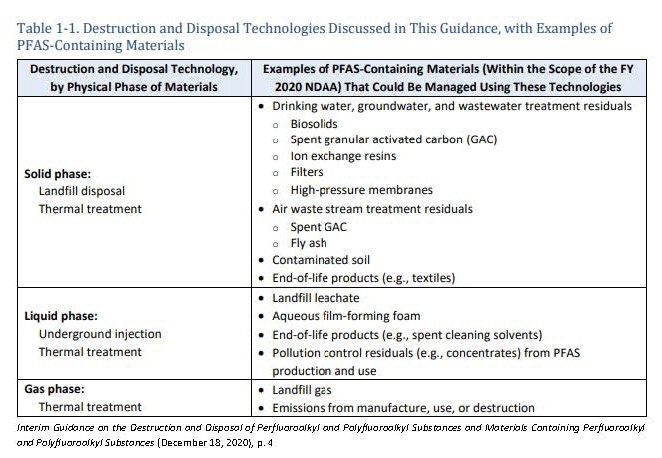U.S. EPA’s Interim Guidance on the Destruction and Disposal of PFAS
Posted: February 18th, 2021
Authors: Kayla N.
On December 18, 2020, U.S. Environmental Protection Agency (U.S. EPA) issued interim guidance for public comment on the destruction and disposal of per and polyfluoroalkyl substances (PFAS) and PFAS-containing materials. This guidance document is in response to the National Defense Authorization Act (NDAA) for Fiscal Year (FY) 2020, which directed U.S. EPA to publish interim guidance no later than one year from the date of enactment of the FY2020 NDAA (i.e., no later than December 19, 2020). The guidance includes destruction and disposal technologies from both existing, publicly available information as well as research and development that is currently in progress. You can read the full interim guidance document here, but an overview is below.
Chemicals/Materials Covered:
The guidance specifically addresses six PFAS-containing materials as specified in the FY2020 NDAA. However, U.S. EPA notes that “…the information included in this guidance would probably be suitable for other types of PFAS and PFAS-containing materials…” The six materials are:
- Aqueous film-forming foam (AFFF)
- Soil and biosolids
- Textiles, other than consumer goods, treated with PFAS
- Spent filters, membranes, resins, granular activated carbon (GAC), and other waste from water treatment
- Landfill leachate containing PFAS
- Soil, liquid, or gas waste streams containing PFAS from facilities manufacturing or using PFAS
Technologies Covered:
Disposal and destruction technologies are summarized in the guidance document according to the physical state of the PFAS-containing material. As expected, the only currently viable destruction method that is discussed is thermal treatment (i.e., hazardous waste combustors, carbon reactivation units, sewage sludge incinerators, municipal waste combustors, and thermal oxidizers). However, landfilling and underground injection are both listed as viable disposal methods. In addition, note that thermal treatment is stated to have “higher levels of uncertainties regarding their capacity to manage the migration of PFAS into the environment” compared to landfilling and underground injections. This, in part, is due to the potential formation and spread of new PFAS during thermal treatment as a result of incomplete destruction or recombination of reactive intermediates. Table 1-1 from the interim guidance document (below) provides a summary of the identified available technologies.
In order for a disposal or destruction technology to be included in this list, it had to meet U.S. EPA’s intended scope. This means the technology either has the potential to destroy PFAS (i.e., break the carbon–fluorine bonds) or is capable of controlling migration of PFAS in the environment. For this reason, other potential options, such as the land application of biosolids, were not included.
Additional Notes:
There is a lot of very informative, highly-technical information in the guidance document. However, below are a few key items of clarification I believe are worth noting.
- Data is very limited and there is much more we need to learn. As mentioned above, this guidance document was released due to the FY2020 NDAA deadline. In fact, the Federal Register publication notice states “The guidance provides information on technologies that may be feasible and appropriate for the destruction or disposal of PFAS and PFAS-containing materials. It also identifies needed and ongoing research and development activities related to destruction and disposal technologies, which may inform future guidance.” Emphasis added in bold text.
- This guidance does not represent an enforceable rule or policy.
- The guidance does not establish a PFAS concentration threshold that would trigger the need for “destruction” or “disposal”.
- Interim storage (approximately two to five years) is noted as a potential option while research continues on some of the more “uncertain” technologies. This is an option if immediate destruction or disposal is not critical.
- The guidance document also addresses the concept of Environmental Justice and the need to evaluate potentially vulnerable populations living near PFAS destruction or disposal sites.
U.S. EPA is accepting public comment on this guidance until February 22, 2021 and we are expecting U.S. EPA to receive many comments on this controversial topic. Please contact me with any comments or questions at kturney@all4inc.com or (610) 422-1143.


